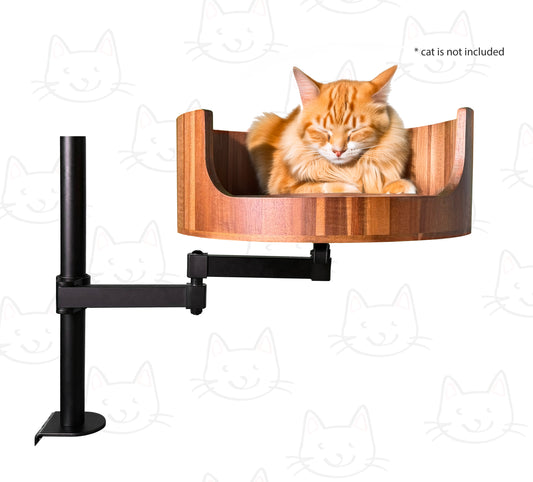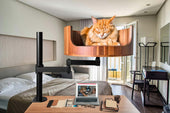
Cat Tail Shaking: Understanding Your Feline's Behavior
Share
If you're a cat owner, you may have noticed your furry friend shaking its tail from time to time. While tail shaking is a common feline behavior, it can sometimes be confusing or concerning for pet parents. In this article, we will delve into the reasons behind cat tail shaking and help you understand what your beloved pet is trying to communicate.
From playful twitching to aggressive thrashing, cat tail shaking can convey a wide range of emotions and intentions. By learning to interpret your cat's tail movements, you can better understand its mood and address any underlying issues. We will explore the various meanings behind different types of tail shaking, as well as provide tips on how to respond appropriately to your cat's behavior. By gaining insight into your feline companion's body language, you can strengthen the bond between you and ensure a happy and harmonious relationship.
1. Cat tail shaking can indicate a range of emotions, from excitement to fear, and it's important to understand the context in which it occurs.
2. Tail shaking can be a form of communication for cats, showing their mood or intentions towards other animals or humans.
3. Observing other body language cues alongside tail shaking can help decipher the message your cat is trying to convey.
4. Excessive or abnormal tail shaking may be a sign of underlying health issues and should be checked by a veterinarian.
5. Building a strong bond with your cat through understanding their behavior can lead to a happier and healthier relationship.
Causes of Cat Tail Shaking
Cat tail shaking can be caused by various factors, including excitement, fear, or annoyance. When a cat is excited, they may wag their tail vigorously as a sign of anticipation or happiness. On the other hand, fear or annoyance can trigger quick, twitchy tail movements. It's important to observe your cat's body language and the context of the situation to determine the cause of their tail shaking.
Health Issues and Cat Tail Shaking
In some cases, cat tail shaking can be a sign of underlying health issues. Neurological disorders, spinal cord injuries, or even pain can manifest through abnormal tail movements. If your cat's tail shaking is persistent or accompanied by other concerning symptoms, it's crucial to consult a veterinarian for a thorough examination. Early detection and treatment of health issues can significantly impact your feline's well-being.
Communication Through Tail Movements
Cats use their tails as a means of communication, conveying their emotions and intentions through different movements. Tail shaking is just one aspect of feline body language that owners can interpret to understand their cat's feelings. By paying attention to tail positions, speeds, and gestures, you can decode what your cat is trying to tell you. For instance, a cat with a puffed-up tail shaking rapidly may be expressing aggression or fear.
Managing Cat Tail Shaking Behavior
If your cat's tail shaking is disruptive or concerning, there are strategies you can employ to manage this behavior. Providing a stimulating environment and enriching your cat's surroundings with toys, climbing structures, or interactive play can help alleviate stress and reduce tail shaking episodes. Additionally, creating a safe and peaceful space for your cat to retreat to when feeling overwhelmed can promote relaxation and emotional well-being. Consistent positive reinforcement and patience are essential in modifying your cat's tail shaking behavior.
Frequently Asked Questions
What is causing my cat's tail to shake?
There are several reasons why a cat's tail may shake, including excitement, anxiety, or injury. It is important to observe your cat's behavior and seek advice from a veterinarian to determine the underlying cause.
How can a Desk Cat Nest help with my cat's tail shaking?
A Desk Cat Nest provides a comfortable and secure space for your cat to relax and destress. By having a designated area for your cat to retreat to, it can help reduce anxiety and potentially decrease tail shaking episodes.
Is the Desk Cat Nest suitable for all sizes of cats?
Yes, the Desk Cat Nest is designed to accommodate cats of various sizes. The spacious and cushioned interior provides ample room for cats to stretch out and curl up comfortably.
Can I easily clean the Desk Cat Nest?
Yes, the Desk Cat Nest features a removable and washable cushion, making it easy to clean and maintain. Simply remove the cushion and wash it according to the manufacturer's instructions.
Will my cat use the Desk Cat Nest right away?
Every cat is different, so it may take some time for your cat to adjust to the Desk Cat Nest. To encourage your cat to use the nest, try placing some of their favorite toys or treats inside to entice them.
In conclusion, opting for a Desk Cat Bed is a valuable choice for cat owners looking to address cat tail shaking. This innovative product provides a comfortable and secure space for your furry friend to relax and unwind, reducing stress and anxiety that may lead to tail shaking. With its cozy design and plush materials, the Desk Cat Bed offers numerous benefits such as improved sleep quality, enhanced overall well-being, and a cozy retreat for your feline companion. Invest in a Desk Cat Bed today to provide your cat with a peaceful and calming environment to alleviate cat tail shaking.



















































